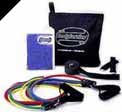Bodybuilders who use heavy weights in their exercise schedules find from time to time that a layoff from the heavy weights is necessary to insure future progress. Most likely, the bodybuilder will use lighter poundages as a substitute from the heavy weights. The problem sometimes arises that the muscles fail to congest from the use of lighter weights even though the body needs a rest from the heavy training.
With this thought in mind, one should consider using the Expanders or Cables in addition to the weights. Unlike barbells, there is very little danger of overtraining with cables. A very brief comment on the physiology of the body will help to explain this statement. With weights (barbells, dumbbells) and other related exercise equipment, your whole body is using a tremendous amount of unnecessary energy just supporting your body weight and the barbell.
Thus, whatever the body part being exercised at the time, that particular muscle will be in a consistent state of violent contraction for the entire set of reps. This causes fatigue to set in much faster.
What Are Expanders and Cables?
Expanders or Cables are so light weight that unnecessary energy is not being wasted supporting your body weight and the cables. So, only the muscle being exercised is using any energy, so to speak.
 Let's take a look for a moment at some of the immediate advantages of cable or expander training. They are very easy to store or transport (great for travel or vacations). The action of expander cables are very quiet so one could use them when weights are not practical. There are three distinct classes of cables or expanders: steel spring, flat rubber, and elastic rubber cord type.
Let's take a look for a moment at some of the immediate advantages of cable or expander training. They are very easy to store or transport (great for travel or vacations). The action of expander cables are very quiet so one could use them when weights are not practical. There are three distinct classes of cables or expanders: steel spring, flat rubber, and elastic rubber cord type.
The steel spring seems to offer more uniform or consistent strength per spring. The main disadvantage in the spring type is that on any movements that are next to the body, they have a tendency to pinch the skin.
Some very general expectations from cable training are:
- Increased chest expansion
- Better breathing capacity
- Very beneficial internal massage on the organs and muscles.
At this point of the article, we will now concentrate on how the bodybuilder can apply this expander cable training into his schedule of weight training.
Bodybuilders selecting sets, reps, and rest periods in cable training should do this for their particular needs and goals, that they have at the time they are considering expander cable training. For example, if your goal is to achieve greater upper body muscularity, a specialized cable training course of 30 minutes to one hour, 4 days per week is best. These 4 days, you will find yourself using only the cables and the other 2 days using the weights. At this time, I would like to share with you some points which will help your specialized expander cable training to assure the best results in muscularity.
Design Tips
- During this 30 minutes to 1 hour program (four days per week), use speed with smooth movement in each of your exercises.
- Strive for shorter rest periods between each set of exercise. In this way, you will be able to add more and more sets in the allowed 30 to 60 minute program.
- One of the most important points or phases in expander cable training is "As you pull the cables throughout the movement, more and more tension is put on the tendons, ligaments, and muscle areas."
Thus expander, cables have the faculty of stimulating growth faster because of the increased resistance they are stretched through the full range of the movement. In the high range or completed areas of the exercise movement, concentrate on a deeper, wider stretch. - For added muscularity, hold the maximum stretched position for a slight second before beginning the next repetition.
If you don't want to specialize on expander cable training four days per week as suggested, this is how I would encourage a bodybuilder (competitive) to use cables in a heavy barbell program. Plan your total barbell and expander cable training program at least six months ahead of a contest.
During the first two months of training toward the contest, perform 2 sets of expander cable work after all of your sets per one body part have been worked. An example would be, after you have completed all of your arm work (biceps), finish off with 2 sets of expander cable curls. Use this type of system within whichever muscle group is worked on a particular day of training. During the third and forth months of training for the contest, perform 3 sets of expander cable work per body part. And finally, during the fifth and sixth months, perform 4 sets of expander cable work per body part.
As a summary, this is how your training for a six-month period might look.
The Program
First Two Months
Deltoids: 2 sets of cable movements*
Biceps: 2 sets of cable movements*
Triceps: 2 sets of cable movements*
Chest: 2 sets of cable movements*
Lats: 2 sets of cable movements*
Traps: 2 sets of cable movements*
Forearms: 2 sets of cable movements*
*After all weights related work has been done for this area.
Third and Fourth Months
At this point, you may simply add one additional cable set to each body part for a total of three sets
Fifth and Sixth Months
During this final 2 months, you will perform a total of 4 sets per body part of expander cable movements.
Some of the very best movements in expander cable training to apply to the training above or cable training in itself is as follows: Deltoids (Two-hand up right rowing under the chin, Front cable raise, elbows locked); Biceps (one-arm curl); Triceps (two-hand triceps stretch. This is done with palms down, elbows locked in front of the body. Concentrate on stretching the cables to the side. Archer's movement); Chest (Chest pulls in front of the body. Arms locked); Lats (One arm cable rowing); Traps (Cable shrugs); Forearms (Reverse curls. Cable wrist curls either palms up or palms down.).
Since most of you readers are aware of proper exercise performance, I will not go into a description of each of the listed movements.
What Kind Of Rep Range?
The best repetition schedule to follow when using cables, whether specialization or combined with barbells is 10 to 12 reps, this seems to prove best for development. When the 10 to 12 reps are performed easily and you don't feel or obtain a deep burn or ache in the muscle area being worked, it is time to another progressive strand or band to your cable exercise.
The arrangement of movements in cable training is overwhelming. For instance if you are into a specialized expander cable program, you might consider super setting body parts with your cables as with barbells. In this respect, I suggest that you have two cable sets available to accomplish this principle since all body parts are not strong enough to use the same cable strand. This will save you time in making cable strand strength changes if you have both cable sets prepared before you begin your program.
Another type of expander cable training system that you might want to try on the contest preparation schedule mentioned above is the "21" Movement. This was very popular with the use of weights a few years ago. In this performance you (stretch, curl or pull) depending on the exercise at the time from the beginning or low position to half way point for seven reps—now you pull from the locked out or high position to half way for seven reps—now finish off with seven complete reps. This constitutes one complete set.
As mentioned earlier in this article, the expander cable training puts more and more tension in the tendons, ligaments, and muscle areas. Thus through expander cable work, these areas are strengthened in a different way than from weight training. With this thought in mind, the powerlifter would be wise to consider including expander cable(s) as a part of their powerlifting schedule because of the tremendous strength factors involved from the added tendon and ligament work.
Expander cables are great for the vital pumping up at a physique contest and vitally important conditioning for the powerlifter at this chosen contest.
Conclusion
In concluding my notes on cable training, some of the most immediate advantages of training this way come to mind. Expander cables build tendon and ligament strength - flushes the muscle area - gives added muscle tone and gives sharpness to the muscle which cannot be obtained by weights alone.
Be Sure To Also Check Out: The Right To Bare Seam Splitting Arms!
